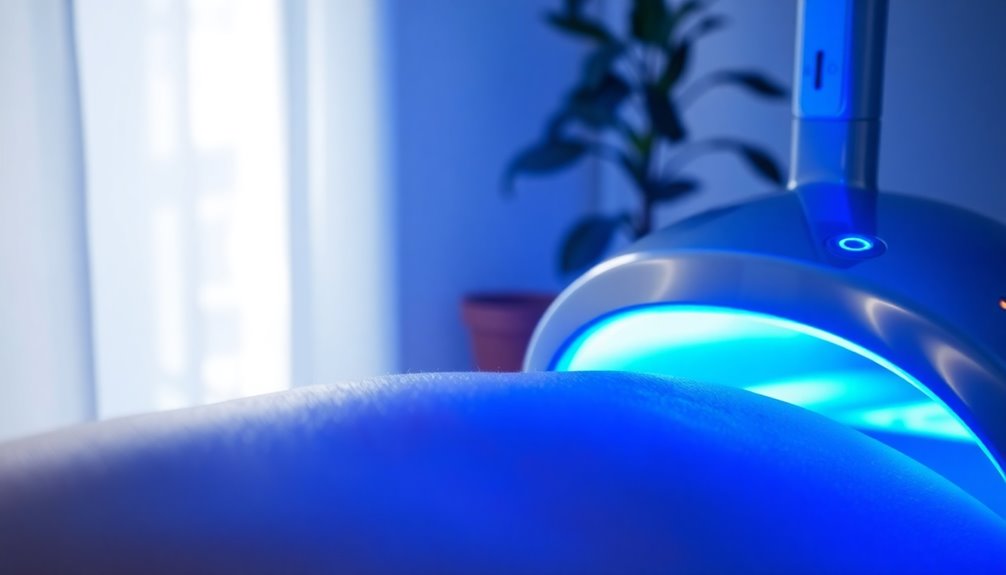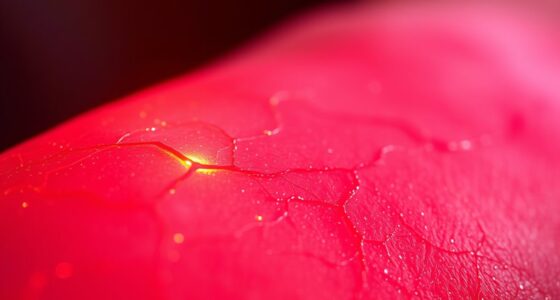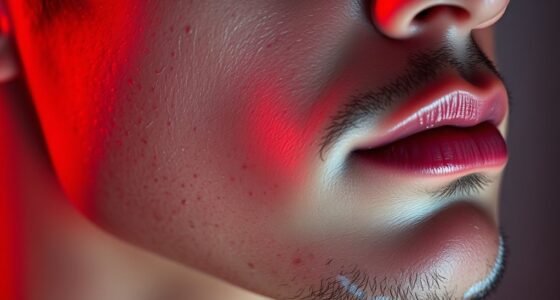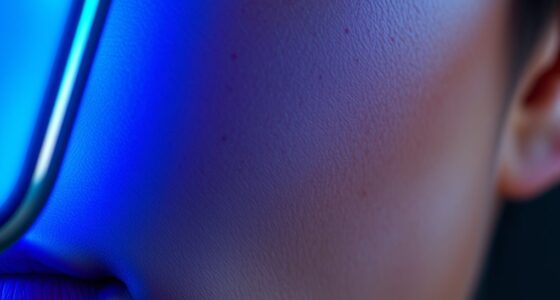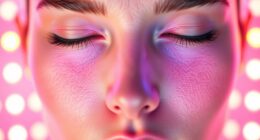Yes, blue light therapy can have side effects, but they're generally mild and temporary. You might experience redness, swelling, or a burning sensation at the treatment site, lasting up to 48 hours. Skin may also peel or become sensitive to sunlight for a while. In rare cases, you could face issues like hyperpigmentation or allergic reactions. It's essential to wear protective eyewear and use sunscreen to minimize risks. Most people navigate these side effects without any major issues, but understanding the specifics can help ensure a smoother experience. There's more to uncover about this therapy and its effects.
Key Takeaways
- Common side effects include temporary redness, mild swelling, and possible discomfort at the treatment site.
- Skin may peel or flake post-treatment, and increased sunlight sensitivity can occur.
- Rare side effects include hyperpigmentation, hypopigmentation, and allergic reactions leading to severe skin issues.
- Immediate side effects may last up to 48 hours and include burning sensations and skin sensitivity.
- Protective goggles and sunscreen are recommended to mitigate risks during and after treatment.
Overview of Blue Light Therapy
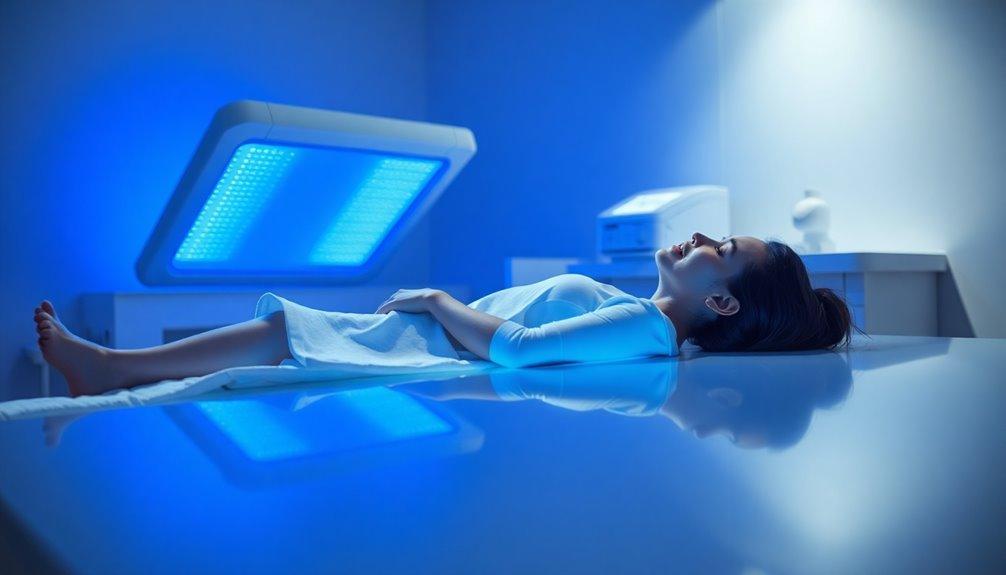
Blue light therapy, while primarily known for treating neonatal jaundice, offers a range of applications that extend to skin conditions, mood disorders, and even certain types of cancer.
You might find it effective for treating acne, psoriasis, and neurodermatitis, as it reduces inflammation and enhances skin texture. For those struggling with seasonal affective disorder (SAD), this therapy can provide mood-boosting light exposure. Additionally, in photodynamic therapy, blue light activates drugs targeting skin cancer cells. Blue light therapy is also utilized to transform water-insoluble bilirubin into water-soluble forms, making it particularly effective in neonatal care.
It's important to note that various light sources, including fluorescent lamps and LEDs, deliver the therapy, with in-office treatments generally being more potent than at-home devices.
Regular maintenance is key for achieving lasting results in skin conditions.
Common Side Effects
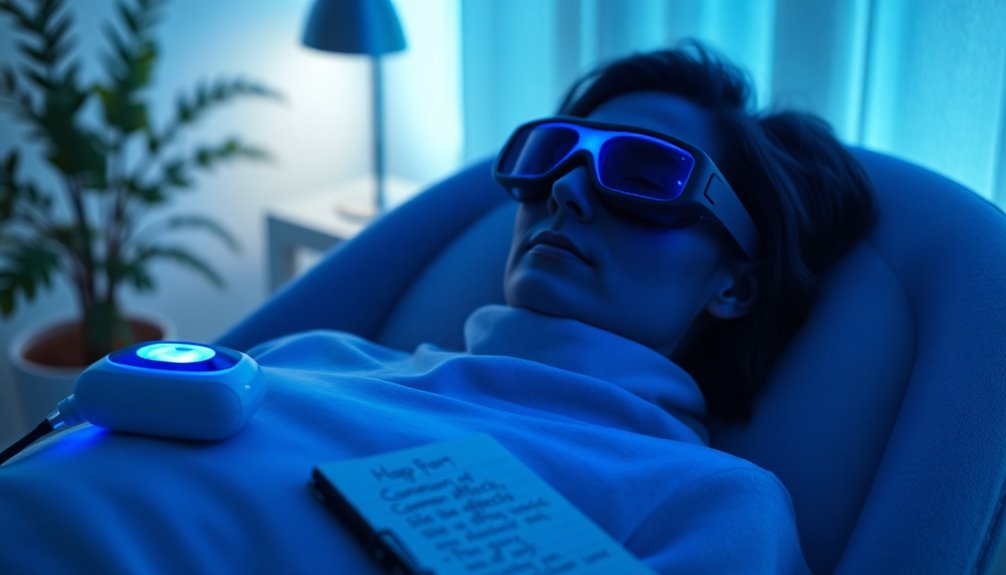
While blue light therapy can be effective for various conditions, it's important to be aware of the common side effects that may arise after treatment.
You might experience temporary redness and mild swelling at the treatment site, typically resolving quickly. It's also possible to feel some discomfort, itching, or a burning sensation in the treated area. Additionally, this therapy is known to effectively reduce acne breakouts, which can be a significant benefit for many individuals.
Your skin may peel or flake, and you'll likely notice increased sensitivity to sunlight for a while. The treated area might change color, and you should take precautions against bright lights and sun exposure.
Wearing protective goggles during treatment is essential, and applying sunblock to the area often will help minimize any adverse reactions.
Rare Side Effects
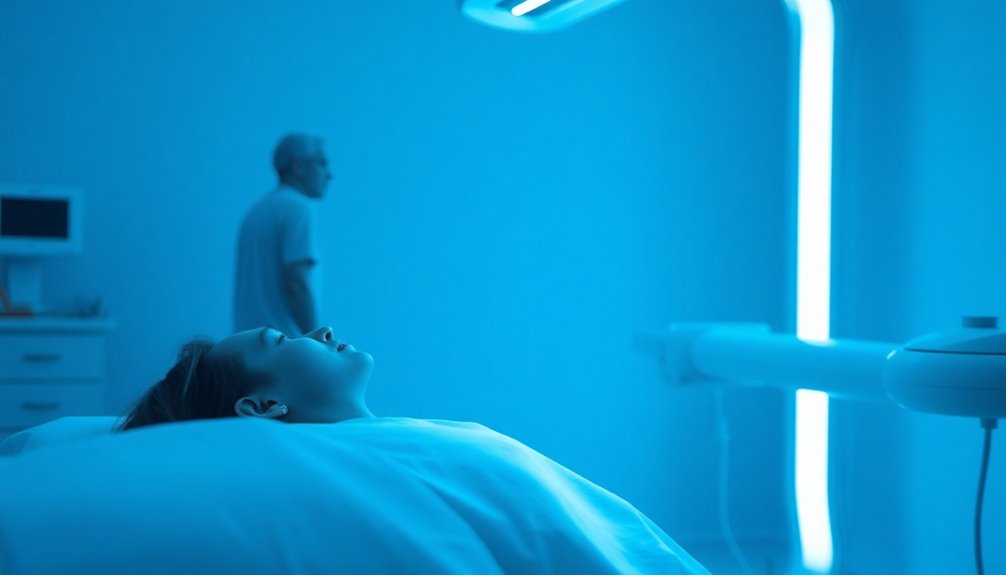
Although most people tolerate blue light therapy well, there are some rare side effects you should be aware of.
One potential issue is hyperpigmentation, which can cause temporary darkening of the skin if aftercare isn't proper. On the flip side, hypopigmentation may occur, leading to lightening of your skin color. Additionally, it's important to note that acne reduction is often achieved with this treatment, minimizing the chances of breakouts that could otherwise lead to skin concerns. Allergic reactions, though extremely rare, can result in severe skin issues needing immediate attention. Additionally, excessive blue light exposure might lead to ocular hazards, impacting your vision over time.
Other minor but uncomfortable side effects, like dry skin, stinging, or irritation, can also arise. To minimize these risks, follow your dermatologist's advice closely and use protective eyewear during treatments.
Specific Study Findings
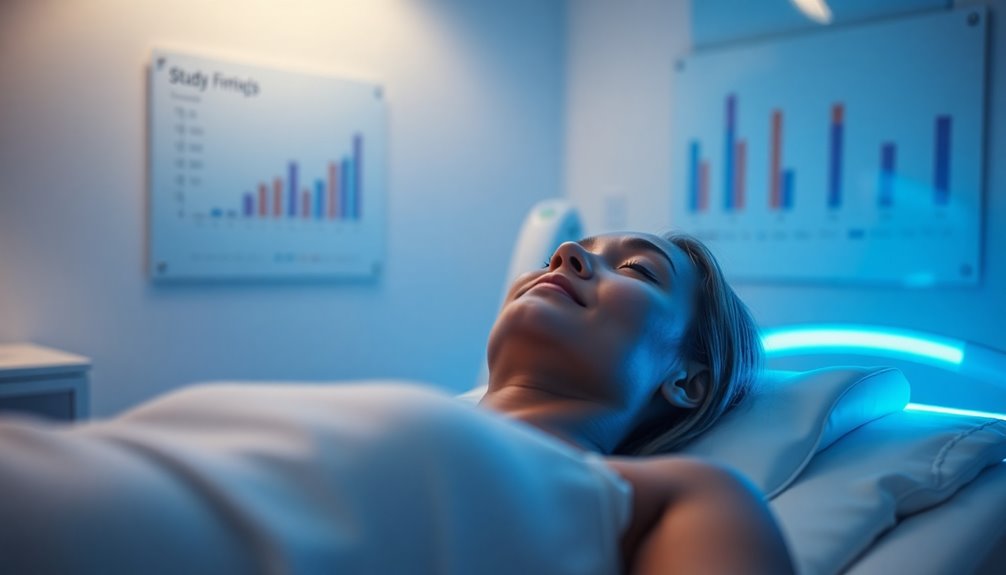
Recent studies have highlighted several specific findings regarding the side effects of blue light therapy that users should consider.
First, excessive exposure can lead to ocular hazards, including age-related macular degeneration and retinal damage, which may cause vision problems. Using protective eyewear is crucial to prevent these risks. Additionally, photodynamic light therapy is a non-invasive procedure that can help treat skin conditions, which may provide relief for some patients alongside blue light therapy.
Additionally, blue light significantly affects your circadian rhythm, balancing its benefits with potential toxicity to the retina.
You might also experience general side effects like eyestrain or headaches, and in rare cases, treatment could trigger a bipolar hypomanic state or suicidal ideation, particularly in those with mood disorders.
Finally, be cautious of interactions with certain medications, which can exacerbate adverse reactions to light therapy.
Precautions to Consider
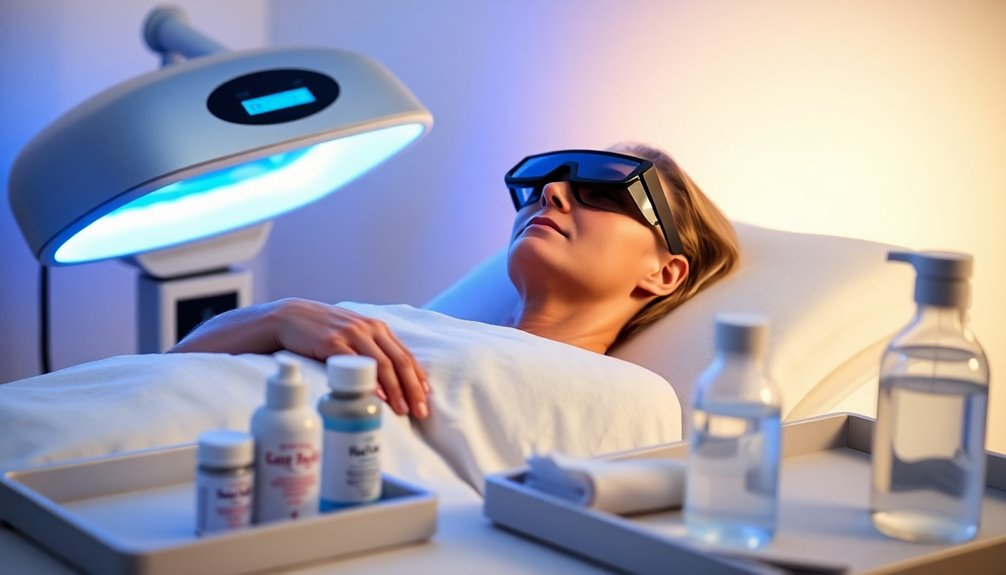
When considering blue light therapy, it's essential to take necessary precautions to minimize potential side effects.
First, protect your eyes with goggles during treatment to avoid irritation or swelling. You might experience blurred vision or redness, so be aware of these symptoms.
After treatment, avoid bright light for 36-48 hours and apply SPF 30+ sunscreen to prevent sunburn. Stay indoors in dim lighting during this time, and steer clear of reflective surfaces like water or snow. It's also important to note that increased sensitivity to light may occur, requiring extra care during your recovery.
Additionally, keep your skin free from irritants, and use cool compresses to soothe any discomfort.
Following your dermatologist's care advice and avoiding touching blemishes can help ensure a smoother recovery and better results.
Benefits of Blue Light Therapy
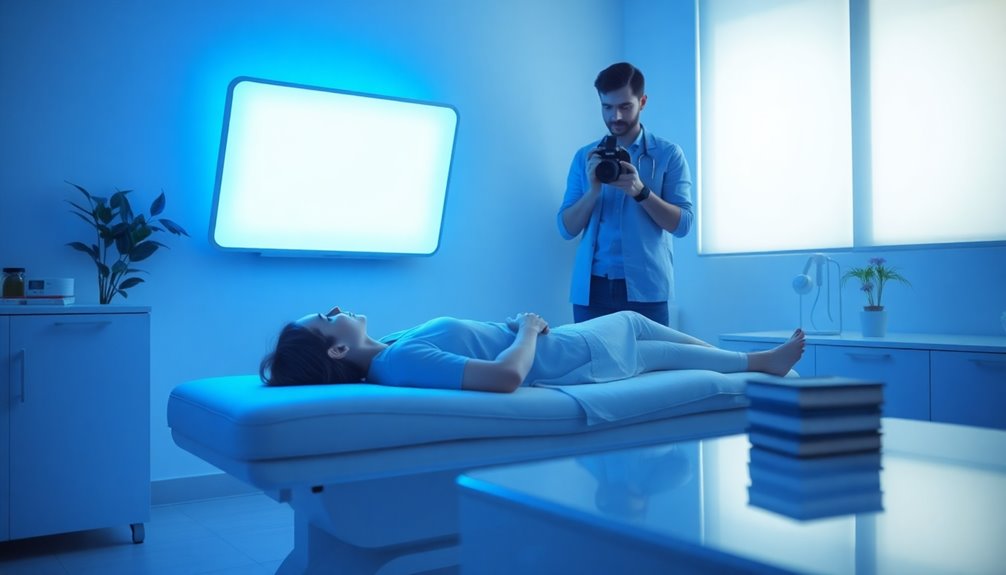
After taking necessary precautions, you can explore the numerous benefits blue light therapy offers.
First and foremost, it effectively reduces acne breakouts, with studies showing up to a 64% reduction in lesions after just five weeks. Additionally, this therapy targets Propionibacterium acnes, a key contributor to acne formation.
You'll also notice improved skin clarity and texture, making it an excellent choice for rejuvenating sun-damaged skin and reducing fine lines.
The treatment is minimally invasive and quick, typically lasting around 15 minutes, allowing you to seamlessly integrate it into your routine.
Plus, it targets specific areas, making it versatile for various skin concerns.
Most importantly, over 90% of participants report enhancements in skin appearance, tone, and smoothness, giving you healthier, younger-looking skin after treatment.
Mechanism of Action
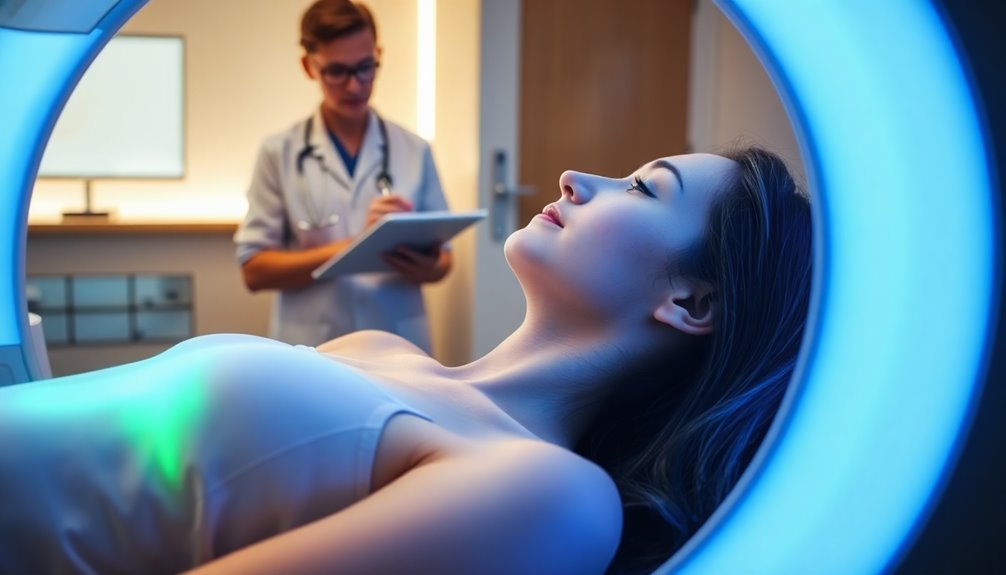
Understanding the mechanism of action behind blue light therapy reveals how it effectively combats acne and enhances skin health. Blue light therapy for acne works by targeting the bacteria responsible for acne, specifically Propionibacterium acnes, which thrives in the sebaceous glands of the skin. By producing a wavelength of light that penetrates the skin, this treatment helps to reduce inflammation and inhibit bacterial growth, leading to clearer skin. Additionally, blue light therapy promotes a more balanced oil production, further contributing to its effectiveness in treating acne outbreaks.
When blue light targets the skin, it excites porphyrins produced by *Cutibacterium acnes*, generating reactive oxygen species (ROS) that destroy bacteria responsible for acne. This light penetrates about 0.3 mm into the skin, focusing on superficial layers. Additionally, blue light therapy modulates inflammatory mediators, reducing inflammation in acne lesions. When combined with red light, the synergy enhances its effects, as red light penetrates deeper and promotes cellular repair. Furthermore, LED therapy's effectiveness is supported by clinical studies demonstrating its role in treating various skin conditions, including acne.
The light absorbed by photoreceptors initiates biochemical changes, activating enzymes necessary for vital cellular functions, further supporting skin health and rejuvenation.
Who Should Avoid It?
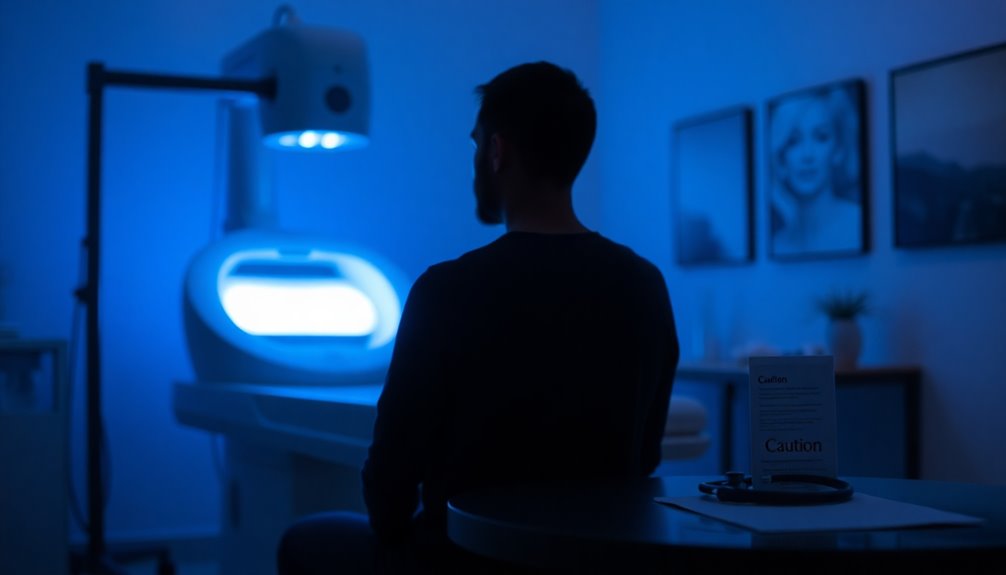
Certain individuals should steer clear of blue light therapy due to potential health risks.
If you're pregnant, especially if you take photosensitizing medications like lithium or melatonin, it's best to avoid this treatment. Those with a history of skin cancer or conditions like systemic lupus erythematosus should also refrain. Additionally, individuals with chronic skin conditions should be evaluated by a specialist before proceeding with therapy.
If you have retinal diseases, such as diabetes, consider skipping blue light therapy as well. Additionally, if you have epilepsy, consult your doctor before proceeding, as the therapy might trigger seizures.
Lastly, if you've recently had Botox or fillers, wait at least five days. Prioritizing your health means being cautious about this treatment.
Post-Treatment Care
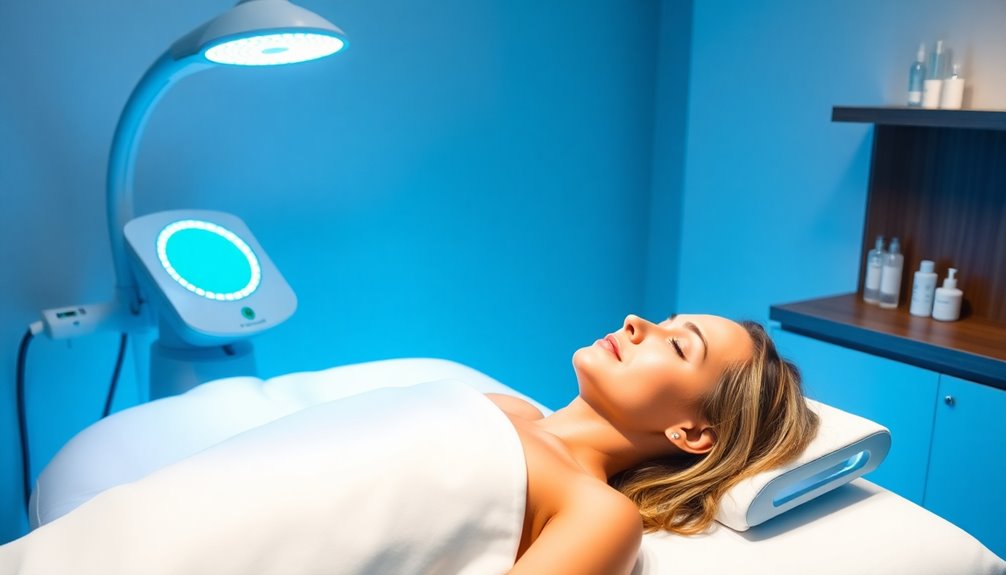
Once you've undergone blue light therapy, it's essential to prioritize post-treatment care to ensure optimal healing and results.
First, avoid bright light exposure, including sunlight, for 48 hours. If you must go outside, use a broad-spectrum sunscreen with SPF 30 or higher. Wear protective clothing and a wide-brimmed hat to shield the treated area.
You might notice redness, swelling, or flaking, which is normal. To manage discomfort, take over-the-counter pain relievers and apply cool compresses. Monitor for redness and swelling for approximately 2 weeks to ensure proper healing.
Keep the area clean with a gentle cleanser and moisturize with Vaseline or Aquaphor. Stay indoors for the first few days, returning to normal activities only after proper protection is in place.
Don't forget to schedule a follow-up consultation if needed.
Expert Opinions and Research
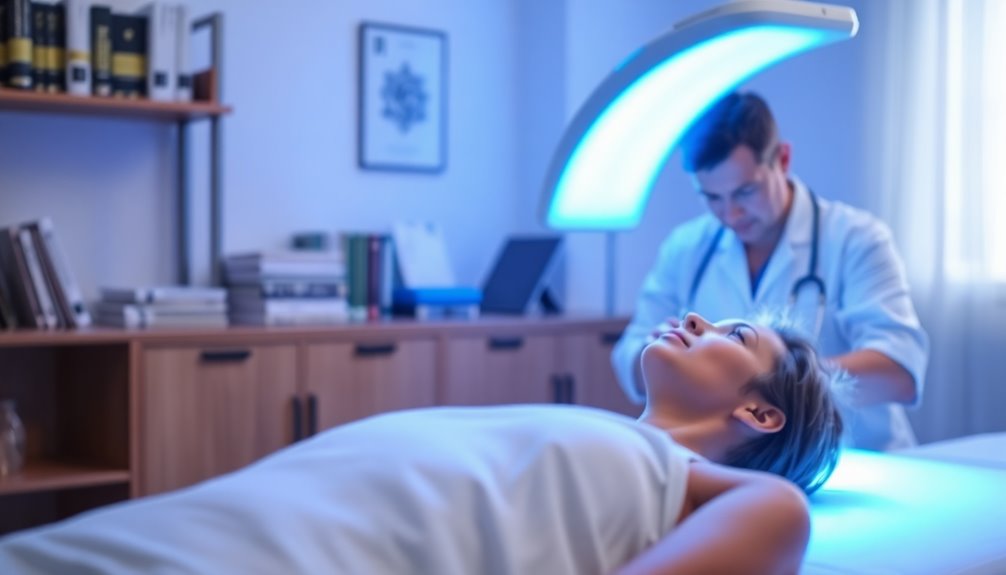
As you explore blue light therapy, it's important to consider expert opinions and the latest research on its effects and safety.
Studies indicate that while blue light therapy is generally safe, you may experience side effects like immediate redness, swelling, or burning sensations. These can last up to 48 hours. Additionally, your skin might become sensitive to light for several weeks post-treatment. Experts warn about ocular hazards; excessive exposure can lead to vision problems, so always use protective eyewear. Clinical findings show blue light effectively treats conditions like eczema, but proper duration and intensity are crucial. Notably, blue light therapy has demonstrated efficacy in treating chronic inflammatory conditions such as psoriasis and atopic dermatitis, highlighting its therapeutic potential. Regular follow-ups enhance treatment effectiveness, and awareness of potential risks is essential for your safety.
Frequently Asked Questions
How Long Do Side Effects From Blue Light Therapy Typically Last?
After blue light therapy, side effects can vary in duration.
Temporary redness and mild swelling might last up to a week.
You may experience increased skin sensitivity and some peeling, which usually resolves within four weeks.
Mild discomfort and itching typically fade within 24 to 48 hours.
It's essential to follow aftercare instructions to minimize risks like hyperpigmentation or allergic reactions, which are rare but can occur without proper care.
Can Blue Light Therapy Be Used on All Skin Types?
Blue light therapy's generally safe for most skin types, so you can benefit from it if you're looking to treat acne or other skin conditions.
However, if you've got porphyria, lupus, or allergies to porphyrins, you should steer clear.
It's effective for treating various issues while being free from UV rays, making it a safer alternative.
Just remember to consult with a dermatologist to ensure it's suitable for your specific skin needs.
Is Blue Light Therapy Safe During Pregnancy?
When it comes to blue light therapy during pregnancy, you might as well be walking a tightrope!
Research on its safety is quite limited, and potential risks like birth defects and fetal development concerns make it a risky choice.
Instead, consider alternatives like LED light therapy or natural sunlight, which are generally safer.
Always consult your healthcare provider before trying any therapy, ensuring you're making the best decision for you and your baby.
How Many Sessions Are Needed to See Results?
To see results from Blue Light Therapy, you'll typically need between 4 to 8 sessions, depending on your specific condition.
Each session lasts around 15-90 minutes, depending on what you're treating. You should schedule treatments weekly or bi-weekly for several weeks.
While you might notice improvements after a few sessions, some patients require maintenance treatments to keep their results.
Consistency is key to achieving the best outcomes.
What Should I Do if I Experience Severe Side Effects?
If you experience severe side effects, seek medical attention immediately.
It's crucial to inform your clinician about any symptoms like burning, swelling, or severe redness. They'll likely recommend reducing treatment duration and may adjust your care plan.
Protect your skin from sunlight and avoid using photosensitizing medications. Always wear protective goggles during treatment and follow your dermatologist's aftercare instructions to minimize further irritation and ensure proper healing.
Regular follow-ups are essential.
Conclusion
In summary, while blue light therapy can be effective for various skin conditions, it's essential to be aware of potential side effects. Have you considered how these effects might impact your treatment experience? By understanding common and rare side effects, along with necessary precautions, you can make an informed decision. Always consult with a professional to ensure it's the right choice for you, and prioritize post-treatment care for the best results.
